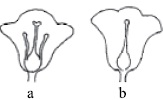Three groups of materials are given below :
I : Salt, sugar, flour
II : Copper, gold, silver
III : Petrol, kerosene, paper
Identify the property common to each group.
| I | II | III | |
| A | Solid | Bad conductors of heat | Liquid |
| B | Edible | Non-metallic | Non-inflammable |
| C | Edible | Metallic | Inflammable |
| D | Solid | Good conductors of heat | Non-inflammable |







